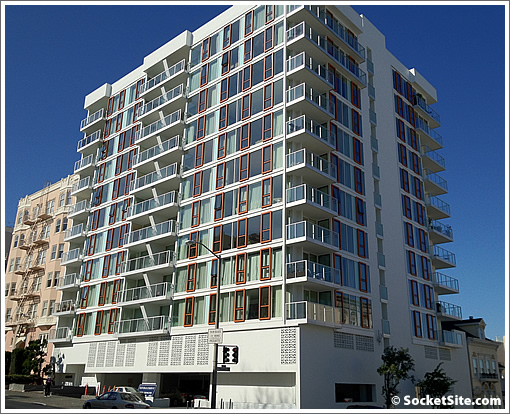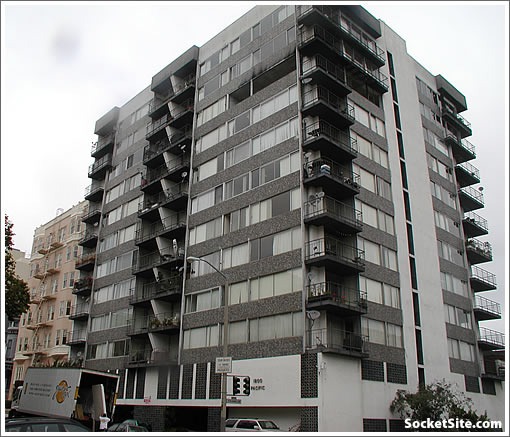
Recently unwrapped, the fractured9 led re-skinning breathes new life and light into the apartment building at 1800 Pacific and Franklin. As the building looked last year, prior to its re-skinning (and in more of a skin-crawling state):


San Francisco real estate tips, trends and the local scoop: "Plug In" to SocketSite™


Recently unwrapped, the fractured9 led re-skinning breathes new life and light into the apartment building at 1800 Pacific and Franklin. As the building looked last year, prior to its re-skinning (and in more of a skin-crawling state):

huge improvement
Wow — I can think of a lot of other properties that should undergo this same sort of overhaul. Have to guess it does miracles for property value.
Used to regularly pass by the building on the way down Franklin. Then, hadn’t gone by in a while so was unaware of the re-skinning, until just this past Sunday, when I went by on foot. Immediate impression was that the new window frames looked tacked-on and out of place, style-wise, and a bit cheap.
Isn’t the conventional wisdom that rent control would prevent this sort of upgrading?
Bravo! I like it a lot more than most of the new buildings going up around town.
I have admired this re-do driving down Franklin. We certainly do not miss the exposed aggregate balconies and short windows. Was disappointed to see that the cement block “garage vents”
were retained. We are also about to lose the exposed aggregate front of Pier 27 . . . hooray, hooray!
It is a big improvement.
The lattice-work cinder-block on the garage level looks like a forgotten step. Wouldn’t cost much to fix: it’s not structural so could be cut and removed or a facade applied.
Rent control is not the only factor when considering an upgrade. This particular building had a significant fire in one of the upper units a few years back, causing damage to the adjacent spaces. That likely helped them decide on the improvement. Also 50% of the capital improvement can be passed on to existing tenants, and the project costs can be depreciated. The increase in value associated with this upgrade can also positively affect the building’s balance sheet.
In person the orange looks cheap…
Helmut, tipster – I can’t see how such a project can affect the building’s balance sheet except in a negative way. No sane appraiser is going to look at aesthetics on an apartment building (might be a small bump from lower maintenance costs of new components), only the current P&L and debt service. With only 50% of the capital costs potentially recoverable and over many years at that, I would have thought that the balance sheet would look quite a bit worse after the remodel. Increased depreciation will help it look less worse but still worse. Not to say that the owners won’t have a much prettier asset and that there might be a small bump in “offerable rent” for the (few?) units that turn over (5-10% annually I would guess). Rent-control certainly does make it hard to finance such renovations in a building with stable long-term tenancies, at least with conventional financing – owners thinking for the long term though might determine that it is a worthwhile investment, especially if they have deep pockets and self-finance.
Many years ago (years before the fire), I lived there in transition between 2 places. Nice views and good location. The outside is improved, but it does look rather cheap – orange? The walls on the inside are rather thin though. A lady and her brother (roommates) would get drunk and scream violently about family issues, extremely disturbing.
If your valuation calculation is limited to GRM then value will only move with rent. If you value based on comps, then upgrades like this will positively affect the value. If your value increases, then your balance sheet improves. Improved balance sheets even in rent controlled properties make for easier capital improvement upgrades.
There are many unknowns. Perhaps there were maintenance issues with the property that the fire exacerbated. The windows, for example, were poor pre-reskinning. If they were aluminum framed single paned (as they seemed to be), then higher performing dual paned windows, with thermal breaks, low e and argon gas filled interiors, would have been eligible for energy star rebates that would have reduced the costs and improved overall building performance (heating & cooling costs saved over time, which are significant)
The upgrade makes sense if you have time on your side.
Just going off of the above comments here since I am a renter not a landlord, but if only 5-10% of units are turning over annually, then vacancies are lower than a non rent-controlled building, no? The cynics on socketsite say that tenants in rent controlled buildings hardly ever move unless they are paid to do so.
That means the owner’s contingency fund for vacancies is either lower (if he’s a risk taker landlord) or he can invest that pot of money and the “earnings from investment activities” account section of his balance sheet is larger than it otherwise would be. Either way, and correct me if I’m wrong, that contributes to the bottom line and offsets some of the cost of the capital improvement.
I love it.
Drive by it twice a day. Seem to have a solid number of people on here who will crticize anything.
The orange looks fine, it doesn’t look “cheap”. The abortion that was it’s previous exterior looked cheap.
Props to whoever did this, huge upgrade.
Walk by it every day, I am sure they got some insurance money from the serious fire that happened in one of the units towards the top.
Dont think it looks cheap at all. To say what exists now is a vast improvement would be a tremendous understatement. The garage tile still sucks, so look up not down.
Some people just cant stand any change, and have a hair trigger need to comment on things that dont affect them at all.
Love it. Two thumbs up.
The lattice is a low cost and elegant way of ensuring ventilation (garage fumes) while maintaining security. Close them off and you have to use forced air for CO and CO2. Remove them and you are opening your garage to non-authorized guests…
I tend to like this option in a 1950s/1960s fetish kind of way.
The old concrete look had to go. Great transformation considering the challenge.
Another argument in favor of this lattice: it also helps bringing light without the use of glass. It probably looks great from the inside.
Would be nice if they’d done something with the ground level.
Helmut wrote:
> Also 50% of the capital improvement can be
> passed on to existing tenants,
Rents can only go up by a maximum of 10% per month and the rent has to be reduced once each tenant has paid for 50% of the improvements.
> and the project costs can be depreciated.
The tax assessor will also increase the assessed value of the building the property taxes will go up. I don’t know the income tax situation of the owner (who paid $2.2mm for the building in 1974), but I do know that the property taxes will be going up and I’ve always ended up paying more in property taxes than I saved in income taxes with depreciation after making a capital improvement to an apartment.
> The increase in value associated with this upgrade can
> also positively affect the building’s balance sheet.
The new windows did increase the “value” of the building but they will “negatively” (not “positively”) affect the building’s balance sheet since the increase in value of the building was less than the cost of the windows.
Then BobTheBuilder (who agrees with me) wrote:
> Helmut, tipster – I can’t see how such a project can affect the building’s
> balance sheet except in a negative way. No sane appraiser is going to
> look at aesthetics on an apartment building (might be a small bump
> from lower maintenance costs of new components),
Then Helmut wrote:
> If your valuation calculation is limited to GRM then value will only
> move with rent. If you value based on comps, then upgrades like
> this will positively affect the value.
The problem is that this building does not have any “sale comps” (when did the last 75 unit bay view apartment in Pacific Heights sell)? As I mentioned above the new windows will increase the value of the building, but not as much as the windows cost.
> then higher performing dual paned windows, with thermal breaks, l
> ow e and argon gas filled interiors, would have been eligible for energy
> star rebates that would have reduced the costs and improved overall building
> performance (heating & cooling costs saved over time, which are significant)
I have looked in to energy star rebates over the years for windows, AC units, heaters and other appliances but I (and every other apartment owner I know) have never got a rebate since you only get the rebates for the super expensive super energy efficient windows and appliances (that don’t make sense for an apartment owner since the tenants usually pay the utility bills)…
It’s not in the tax records yet but a new owner purchased it about 2 years ago at the trough of the recession locally. As I recall, it was among the largest transactions that year at $20+ million as nothing else was selling. The fire plus new management plus a remodel (about $2m) that stretched on for the better part of a year emptied quite a few units…. all in a substantially upgraded building at the edge of Pac Heights with bay views.
This didn’t seem to load the first time I posted it, but this is the building that Jack Lemon and Lee Remick live in in The Days of Wine and Roses.
In perhaps a case of life imitating art, they have to move out of the building because of a fire.
Decorative screens in front of the cinder block vents might help with aesthetics, but probably the project had enough on the balance sheet already. The overall look is greatly improved.
Idle comments
All buildings have comps, appraisers will adjust for differences. If your appraiser does not know how to get a comp for a property, you have a bad appraiser.
Of course the rent is reduced once the capital improvement has been paid off, that is the point of the capital improvement pass through, it is not a rent increase.
Yes,capital improvements can increase assessed value and increase property taxes. That increase in taxes is also deductible.
The most recent rebates I have received have been for heating upgrades through President Obama’s 2009 American Recovery and Reinvestment Act. 40%-60% for boiler replacement, new TRVs, & insulation installation. You may call the SF Department of Environment for information about these rebates (Matt Greco is a good contact) and you may read the SFAA Magazine upcoming green issue, where I will be writing a guest column on the greening of one of my apartment buildings.
UPDATE: A plugged-in reader provides a much better “before” photo for 1800 Pacific which has been posted above. Cheers!
Ser: you are incorrect. the building has not sold since 1974. that’s why it doesnt show in the tax records. i know the owner. also, if it did sell (which it probably never will) it would be at least a $30M sale today…at least.
Stumbled across this entry while doing research on my SF architecture photos.
According to the Encyclopedia of San Francisco, this is the last apartment designed by the prolific SF architect H.C. Baumann (scroll to very end of bio):
http://www.sfhistoryencyclopedia.com/articles/b/baumannHC.html
I think the new windows are a definite improvement, myself.